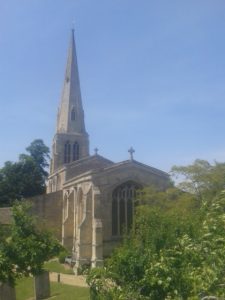Barrowden Church: St Peter

Barrowden Church is dedicated to St Peter.
St Peter’s re-opened in 2019 after a fantastic re-ordering project.
Everything from underfloor heating and WiFi for live-streaming services is laid on. The light and airy building is now both beautiful and useful and major Benefice events are often held here, in addition to events specific to Barrowden.
It is the spiritual heart of Barrowden in Rutland, and is open every day to welcome villagers, visitors and tourists.
History of the Church
St Peter’s is very old, and has certainly changed, sometimes quite radically over the centuries Yet entries in the current visitors’ book constantly remark on its beauty and peacefulness and their happy memories. It seems as if past and present lose their boundaries and merge, and the prayers and faith over the centuries of countless villagers with cares and joys like our own, can resonate with us now.
“Barrowden” is the modern version of an Old English name ending with “dun”, indicating that between 400-700AD an Anglo-Saxon settlement was established here, under a hill which had ancient burial mounds. On the banks of the River Welland, with numerous springs, the situation would have been attractive for agriculture and dwellings. There already had been Roman activity nearby, and there were two Roman roads, one going north to south crossing the Welland where Turtle Bridge now stands,l. Barrowden became a major place within the dower lands of Mercian and English queens and there was an agreement with the Danish invaders whereby these lands would remain untouched by them. In 1086, Domesday Book records that “Berchedone” was an important manor belonging to the King, and there was a priest who looked after 25 freemen, 42 villagers and 26 smallholders
The earliest parts of St Peter’s that can be identified by style are the large iron C-scroll strap hinges on the originally single large entrance door. They date to around 1180. A list of the Rectors of Barrowden was put up in the 19th century, with historical notes concerning the Mauduit family who held the Manor of Barrowden from King Henry III and presented Walter de Rochomage to the Rectory of Barrowden in 1232. The panel also states that the first recorded institution to the Parish was by Hugh Wells, Bishop of Lincoln; this Bishop and the Mauduits had been in conflict with King John.
In 1333 land was given to “maintain a chaplain at the altar of the Blessed Virgin to sing mass there forever” for souls, the gift of land has remained, with monies from its rent helping church upkeep to the present day, and rushes or hay from the fields or their successors are still brought to the church and laid on the floors of nave and porch for the Feast of St Peter at the end of June.
Outside, the lead was removed and replaced with blue Welsh slates, doubtless brought by the busy railway across Eight Arches bridge to Barrowden and Wakerley station, opened in 1859. . It was not until the 19th and 20th centuries that some lay people’s attitudes to change were recorded, as the Victorian Churchwardens’ printed notes concerning the inappropriate newness of blue Welsh roof slates and the awkwardness of iron churchyard gates in relation to cows.
The most noticeable addition to the church in the 20th century has been the creation of the First World War memorial in the south aisle. St Peter’s has also given sanctuary to items from local Chapels after they closed, including furniture from Wing Methodist and Morcott Baptist and also memorial tablets from Barrowden Baptist after its closure in 2003. One of these tablets, for Private Harry Hopkins, who attended Sunday School at Barrowden Baptist Chapel and shortly afterwards lost his life in the Great War, has been set in the south nave wall next to the War Memorial.
Visitors asked for their quick first impressions of the church often comment on how light it is; some are first taken aback by rushes being on the floor at Petertide, then return years later to try to recall the smell they found they loved. Visitors’ Books carry comments by ex-villagers who return and write of happy memories and tell of relatives and friends buried here. People arrive from all over the world and write their thanks that the church was open when they came, of the care given to the building and their enjoyment of its setting.